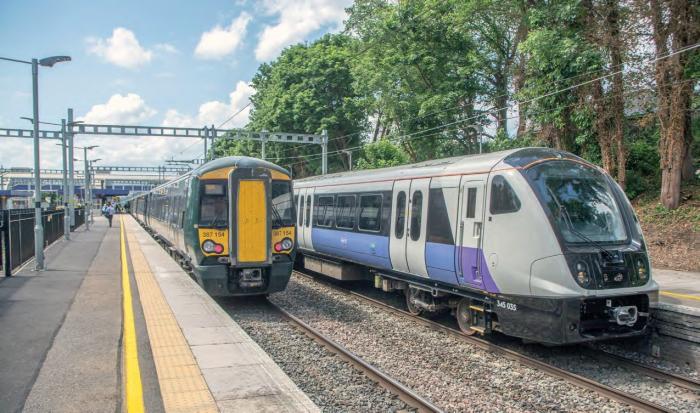Crossrail Update
After announcing a revised schedule that would see the Elizabeth Line open some time between October 2020 and March 2021, the race is on to deliver on this new commitment.
Given that the line was supposed to open at the end of 2018, moving to a 2020-21 window should provide room to maneouvre. Yet already it is clear that the size of the challenges Crossrail faces warns against presumptions that the new deadline will be met.
To realise the six-month opening window set out in the ‘high level programme’ announced in April this year, Crossrail is creating a detailed Delivery Control Schedule. Key to this is getting the Class 345 train fleet to work with the signalling and control systems in tunnels.
Close headway multi-train testing in the tunnels is underway, with a minimum safe distance between trains, at slow speed, of 50 metres. During July testing saw the speed of the trains progressively increased and more of the automatic train operation functions brought into the testing programme
.
But there’s a long way to go from operating four trains at a time to running between 30 and 50 simultaneously, as will be required to get the Elizabeth Line open.
In its latest four-week report, the beefed up Crossrail Project Representative says that the production of a robust dynamic testing schedule can only be confirmed once the requirements of both rolling stock and signalling have been incorporated into an integrated schedule. The P-rep report makes clear that this is one of the most urgent priorities for Crossrail in finalising the Delivery Control Schedule and opening the Elizabeth Line within the stated six-month window.
Signalling supplier Siemens and train manufacturer Bombardier are continuing to develop the train control software to a level that will allow full trial running to start early in 2020. But trial running also requires progress in other aspects of testing and commissioning, including communications systems and also on the physical infrastructure, notably at Bond Street station. Transport for London’s latest Programmes and Investment panel update on the project cautions that while the start of close headway testing is an important milestone, significant work lies ahead for both the project and all its suppliers.
Aside from the uncertainty about the train and signalling delivery dates the P-Rep warns that the production rate for regulatory safety and technical assurance documentation by contractors and Crossrail must increase if the Delivery Control Schedule completion dates are to be met. Incomplete operations and maintenance manuals are said to be a significant risk to formal handover.
All this is about getting the core Elizabeth Line open – what we know as stage three. Look beyond this to joining up the tunnels with the surface lines and the challenges are even greater. The TfL panel has described the step from stage three to stage four (connecting the Shenfield route to the tunnels) as ‘relatively large’. A proposed opening date range for stage four is expected to be announced this autumn.
READY FOR ACTION?
While the trains and the stations remain far from ready, the people and the mechanisms that will look after the finished assets are getting into position.
As part of the operational readiness effort, maintenance teams started moving into the new Maintenance Management Centre at Plumstead at the end of June 2019. Training and familiarisation continues, although transfer of maintenance information from contractors has been slower than planned. Some limited track inspection is now being carried out by maintenance teams and TfL says this has proved valuable.
Some more good news: Elizabeth Line assets including portals and shafts are being handed over to TfL operational and maintenance teams. Less good: asset and maintenance information data is not up to the required standard and further work that needs doing has been identified. More worrying, these handovers are the simple ones – if there are problems with ventilation and access shafts, what can we expect when the stations are transferred?
TfL says a more rigorous handover process is now being devised. It notes: ‘This is vital as the handover process needs to be trialled and optimised with “simple” assets such as the shafts and portals before the major station and routeway completions commence later in the year’.
MOTIVATING BECHTEL
Programme Delivery Partner Bechtel has made a good living from Crossrail for more than a decade, but its delivery credentials were dented by the revelations that Crossrail will bust its budget and open years later than planned. Earlier this year the National Audit Office noted that efforts to integrate Bechtel and Crossrail staff had resulted in a situation where Crossrail Ltd had few commercial levers to drive management and integration of the overall programme (Modern Railways, June 2019).
Aside from whether the incentives for Bechtel in the April 2009 contract have had value in delivering Crossrail to date (the PDP contact required Bechtel to provide services against a scope, an annual service delivery plan and a schedule of deliverables), TfL has concluded that the recent changes to the delivery schedule make the previous contract incentives ineffective. It therefore plans, subject to the Department for Transport agreeing, to renegotiate the contract with Bechtel.
Rethinking Bechtel’s relationship with Crossrail appears long overdue – although commercial confidentiality means it is unclear what form the new arrangement will take. While it offers an opportunity to refocus Bechtel’s efforts on getting the Elizabeth Line finished, changing the PDP deal may not come cheap.

